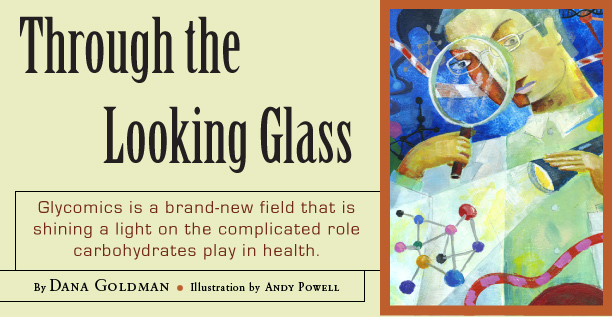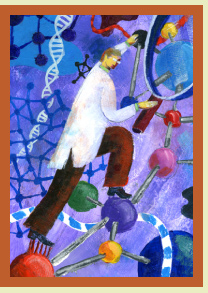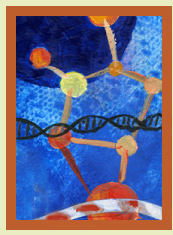|














|
 |
| |
|
|
| |
  |
|
| |
|
|
 |
Forget
about what’s on your plate. Forget everything you’ve
been told about good carbs, bad carbs, and complex carbs.
Instead,
prepare to fall down the rabbit hole and feast on this: Carbohydrates
may be the key to just about everything that goes right in the human
body—and everything that can go wrong.
Enter glycobiology, the study of carbohydrates—and
one of the approaches Emory is taking toward transforming health
and healing.
"This is a new era where we’re
connecting the structures of carbohydrates to biologic functions,"
says glycomics expert Richard Cummings. Less than a year into his
tenure at Emory School of Medicine as chair of biochemistry, he
has amassed a team of 20 to begin magnifying the connections between
carbohydrates and disease.
Since each disease, organism, and
type of cell has its own unique carbohydrate structure, the connections
are indeed numerous. But the effort of decoding each carbohydrate
may well be worth it. After all, Alzheimer’s disease has struck
more than 24 million worldwide, and 25 million Americans get the
flu each year. While the flu and Alzheimer’s have little in
common besides those numbers, the different carbohydrate structures
involved in these diseases may hold the key to locking both away—not
to mention hundreds of other diseases. |
 |
| |
|
|
 |
Taking
the glue out of carbs
While the stakes are huge, the science is relatively
clear: For bacteria and viruses to take hold in the human body,
they have to stick to cells. They have proteins that bind to carbohydrates
(also called glycans). These glycan-binding proteins, or GBPs, seek
out carbohydrates on the surfaces of the cells of the human host.
All human cells also express a battery of different GBPs that are
important in human cell biology and cellular interactions—for
example, sticking together.
If scientists can block carbohydrates
from sticking to proteins, they may be able to block disease from
taking hold as well. And the odds are in the scientists’ favor.
"The GBPs as a kind of group are among the most abundant class
of proteins encoded by the human genome," says Cummings. "In
addition, every virus we’ve looked at binds to carbohydrates.
So a new paradigm is forming—all glycan structures may be
bound by a GBP, either expressed by our own cells or cells of disease
organisms."
Cummings’s magnifying glass
has already shown that the link between carbohydrates and infection
extends beyond people. "Even clams have an inducible immune
system based on carbohydrate-binding proteins," Cummings says.
"This concept of the importance of carbohydrate-binding proteins
is evolutionarily an ancient idea. From the original multi-cellular
organisms to the most complex organisms that exist today, all have
carbohydrate-binding proteins."
Wonderland
population: several million,
and counting
Forget the clams—cataloguing the entirety of human carbohydrate
structures is no small job. "In the human glycome, we’re
estimating there are several million carbohydrate structures,"
says Cummings. Unlike DNA, these carbohydrate structures are not
stagnant. With an elusiveness worthy of the disappearing and reappearing
Cheshire cat, they shift forms when gene expression changes.
The complexity of the human glycome
means decoding it may take longer than any one scientist’s
career. "In my lifetime, I’ll never hear the term, ‘the
end of the glycomic era,’" Cummings says. "We
think we’re only a small percent of the way there. And since
we don’t know the total number of structures—or how
they change depending on diseases, environmental issues, and health—the
numbers could be even larger."
Over the past 10 years, nanotechnology
and mass spectrometry have made isolating and analyzing carbohydrates
a much quicker process, creating a growing buzz in scientific circles.
In fact, the buzz over carbohydrates and those protein-carbohydrate
structures called glycoconjugates, is big enough to keep Cummings and his team
busy for years to come.
called glycoconjugates, is big enough to keep Cummings and his team
busy for years to come.
Then there’s the Consortium
for Functional Glycomics, the hub of the glycomics wonderland. The
consortium includes eight core facilities worldwide—including
Emory—all magnifying different pieces of the glycomics puzzle.
Through that consortium, funded by the National Institute of General
Medical Sciences at NIH, Cumming’s lab analyzes carbohydrate
structures from samples sent from around the world—for free—and
then makes the results public. "At any one time, our core
facility here is probably working with 50 research laboratories
around the world," says Cummings.
Offering Emory’s magnifying
power gratis is changing the face of science. With the NIH fronting
the costs, decisions about who gets access to this cutting-edge
science are based on the merit of projects rather than money. An
investigator who may have limited experience analyzing carbohydrate
structures, or insufficient resources to do so, sends in samples.
Emory extracts the data from the samples and makes the results public.
The investigator uses those results for a paper in a scientific
journal, disseminating information to an even broader audience.
In effect, the consortium and Emory are speeding up the transfer
of information and offering a new model for how research can be
conducted globally.
No
longer fantasy
For an idea of how glycobiology may change our view of the world,
consider the parasitic disease schistosomiasis. Two hundred million
people worldwide are infected with the disease, and its manifestations
can be severe: bladder cancer, kidney failure, mental retardation,
and muscle weakness.
Cummings and colleagues have discovered
that the parasitic flatworm that causes schistosomiasis has carbohydrates
bound by proteins in human hosts. "We identified its carbohydrates,
and now we can use them to make a vaccine," says Cummings.
"For people who are already robustly immunized with antibodies
to those sugars, the vaccine should be able to attack and kill that
parasite as soon as it shows up."
Targeting carbohydrates to treat a
disease was seen as a science fiction fantasy just a few years ago.
"Even among vaccine people, this is really novel," says
Cummings. But while creating vaccines based on carbohydrates might
be novel right now, implications of carbohydrate research go much
further: toward healing inflammatory, cardiovascular, and autoimmune
diseases as well as stopping heritable ailments and metabolic disorders.
"Our work impacts all of those areas," Cummings says.
In fact, one of Cummings’s biggest
discoveries was the finding that human white blood cells that fight
infection express a glycoprotein on their surfaces that is bound
by a specific GBP in the cells lining blood vessels. This interaction
is key to the inflammatory response and allows people to respond
to infections. But in some human diseases, there is inflammation
without infection and the white blood cells become activated. They
use these GBPs to get into tissues where they can cause tremendous
damage, such as sickle cell crisis and inflammatory bowel disease.
Cummings and his colleagues are trying to develop new therapies
that target these GBPs as a way of treating or reducing the inflammation.
Where
to focus the glass
If the results of glycobiology have the potential to be astounding,
so too are the sheer numbers of those findings. A single scientific
research paper would be unable to encompass the information needed
to describe the carbohydrate structures in a single tissue or organ,
according to Cummings. Websites are being filled with information
that is available from the Consortium for Functional Glycomics.
Currently, Cummings is writing the second edition of the textbook, Glycobiology, to give an overview of what carbohydrates
do and how they function, and it has taken him and co-writers 50
chapters just to do that.
textbook, Glycobiology, to give an overview of what carbohydrates
do and how they function, and it has taken him and co-writers 50
chapters just to do that.
More glycobiology textbooks will surely
be coming, as Cummings and other glycobiologists continue to advance
the field. "Our glycomics ability now is like a giant magnifying
glass. It can burn a hole through a problem," says Cummings.
"Where do you want to put this magnifying glass? Do you want
to burn a hole through a specific health problem? Do you want to
know all the glycans in everybody’s blood and in every human
condition? It’s doable. We’ve figured out how to do
it."
At Emory, Cummings is turning the
glass on three major areas. He’s forming collaborations to
focus on predictive health and disease diagnostics. In these studies,
blood and other tissue samples will be screened by mass spectrometry
to define the levels and kinds of carbohydrates on different glycoconjugates.
Changes in carbohydrate expression and structure are associated
with many human diseases, and early detection could lead to new
insights into predicting and diagnosing disease. In addition, GBPs
and antibodies in human blood recognize carbohydrates. Their expression
can be important to the ability to fight infection as a part of
"the innate immune system." This type of immunity is
inherited and always present rather than being triggered by a specific
pathogen or virus.
Following what he learned from schistosomiasis,
Cummings also will help create new vaccine-based approaches to human
disease, where carbohydrates are coupled to carriers and used for
vaccination. This approach, carried out through the Glycomics Center
in the medical school, could lead to a new era of preventives for
many parasitic diseases.
Then, there are his plans for neurobiology: "The one giant,
unexplored universe of glycobiology is the brain," Cummings
says. "We know that the most unusual glycoconjugates in the
body are found in the brain, and we know the least about them."
All of these projects are a welcome
challenge to Cummings, who believes the biggest discoveries are
yet to come. With his magnifying glass in hand, he’s seeing
the influence of carbohydrates everywhere he looks. And to him,
that’s reason enough to fall down the rabbit hole.
Dana
Goldman is a teacher and freelance writer for print and radio in
Atlanta. |
 |
 |
 |
| |
|
|
 |
 |
|
 |
 |
A
Glyco-Glossary
Glycan-binding proteins (GBPs): proteins
that bind to carbohydrates secreted by cells or on the surfaces
of cells; also called carbohydrate-binding proteins or lectins.
Glycan array: an instrument that enables
scientists to put thousands of different carbohydrates on
glass slides and then analyze their binding to GBPs expressed
by human and animal cells and to bacteria and viruses.
Glycobiology or glycomics: the study of carbohydrates’
functions, structures, and purposes.
Glycoconjugate: a complex carbohydrate that
is linked to a protein, fat, or polypeptides and proteins
containing amino acids.
Glycome: the entire spectrum of carbohydrates
in a cell or organism.
Glycosylation: The addition of a carbohydrate
or carbohydrates to a protein.
Quantitative mass spectrometry: a tool used
to figure out what molecules—and how many—are
in a particular compound. By analyzing and quantifying which
carbohydrate structures appear in different molecules, scientists
can detect different diseases. |
 |
| |
|
|
|
 |
| |
|
|
| |
|
|
|
|
|

